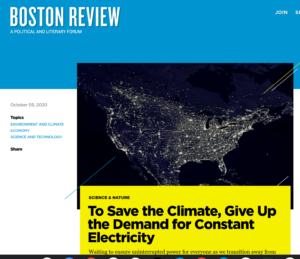Heartland Institute’s Andy Singer comments on Rutger’s professor’s energy policy.
#
By DAVID MCDERMOTT HUGHES – David McDermott Hughes is Professor of Anthropology at Rutgers University and author of Energy without Conscience.
Many decades ago electricity became the new oxygen, and the vast majority of Americans today believe they need it every moment of every waking or sleeping hour. The United States has built a vast infrastructure for generating, transmitting, and consuming it—all almost entirely based on planet-destroying fossil fuels and nuclear power.
Electricity has become the new oxygen. The vast majority of Americans today believe they need it every moment of every waking or sleeping hour.
Those fuels hold and store energy. If you accumulate enough of them, you can generate electricity abundantly and reliably. The result is that the average American household uses electric resources far beyond its needs while losing power for fewer than six hours per year. Renewables can provide that plenitude—and already do through wind and solar farms in Texas and California—but not necessarily all the time. The sun shines at us constantly, with more energy that we can possibly use at any moment, but the Earth’s rotation puts us in shadow at nightfall. And wind, of course, can simply stop. As a result, the leading fossil- and nuclear-free sources of energy bounce from feast to famine, raising the possibility of more frequent and longer power cuts. Critics—often supporters of natural gas—say wind and solar power are “not ready.” Renewables, they warn us, pose an “intermittency problem.”
For those seriously concerned about climate change, the inverse—the demand for electrical continuity—may be the real problem. Today’s most ambitious plans to abandon fossil fuels—which are certainly not supported by the natural gas industry—allow ten, twenty, or thirty years to wire the whole country with solar and wind power, running all day, every day, for everyone, everywhere. The plans differ in speed, but all agree on the last point: except for six agonizing hours per year, electrons must flow 24/7/365. To make that steadiness possible, solar plants will have to store some electricity during the daytime feast to last through the nocturnal famine. “As economies shift to variable renewables,” environmental activist Paul Hawken writes in his aggressive climate proposal Drawdown (2017), “management of the power grid with energy storage systems is critical.”
We ought to consider enduring much more than six hours of electrical downtime every year for the sake of transitioning more rapidly away from fossil fuels.
But storage means batteries, and battery technology takes time to sell and install. In the case of utility-scale batteries or battery farms, investors have to negotiate with regulators and neighbors. Such friction is impossible to measure now, but additional equipment and infrastructure always create delay. That lost interval—years, in each of the transition scenarios—matters profoundly. Carbon dioxide can trap heat in the atmosphere for 120 years. For the most precarious people, a year’s emissions mean the difference between life and death.
So just how critical is continuity, then? And critical for whom? The U.S. grid sends 30 percent of its electricity to residences. As of 2017, 63 percent of those were single-unit, detached dwellings. Under Hawken’s plan in Drawdown, these houses will require battery farms and high-tension lines, and until they get them, they will probably draw power from natural gas at night. Thus, each household demanding continuous electricity marginally exacerbates the climate crisis. Perhaps, then, it is critical that we not store energy for these houses. At least, we should not do so in a way that hobbles the transition away from fossil fuels. We ought to consider waiting a few years for storage—enduring much more than six hours of downtime every year—for the sake of transitioning more rapidly away from fossil fuels. But few people have championed such residential intermittency. Why not?
Self-sacrifice is not popular, especially at home. After Jimmy Carter suggested we turn down the thermostat in winter, Ronald Reagan banished sweaters to the political graveyard. No one will recommend that we spend the winter being cold. Forgoing the stove for a few hours is a different kind of sacrifice; it doesn’t degrade our quality of life so much as reschedule or interrupt activities. Delay is the kindest form of rationing. Yet we are so wedded to availability, predictability, and continuity that any break seems like a sacrifice. Long before the lithium-ion battery, we became addicted to electrical continuity.
Self-sacrifice is not popular, especially at home. After Jimmy Carter suggested we turn down the thermostat in winter, Ronald Reagan banished sweaters to the political graveyard.
This steadiness became normal and expected at home and in the economy when—and precisely because—the home and the economy converged. First, they diverged from a common concept. As developed in the seventeenth century, the term “economy” derives from the Greek word for household or family management (oikonomos). Both units rely upon internal cooperation. In the seventeenth and eighteenth centuries, they also ran at roughly same tempo: when breadwinners slept, so did production and trade. Factories of the Industrial Revolution, however, moved to continuous production. High-energy manufacturing—in blast furnaces, for example—was just too costly to stop and restart. The economy of making goods thus became an insomniac while the family slumbered. Then, for buyers, sellers, and traders of goods, the digital revolution set an alarm clock without snooze. “Business continuity” is now vital—defended from hackers and blackouts alike. So just about every part of the economy outstripped the family completely. The former is always on, whereas the latter—except where someone works the night shift—appears to turn the lights off at night.
In subtle ways, the family has been catching up to the economy. Perhaps, the change began in the 1960s when the electric clock replaced the wind-up alarm. This technology turned an unnoticed midnight blackout into potentially career-wrecking tardiness. Then the digital clock colonized all our appliances, from the TV to the stove: you can’t turn them off anymore. If the contractor installs them compactly, you can’t even unplug them. Now—through the Internet of Things—they are all going to talk to each other all the time. That will certainly be convenient; houses will run themselves, heating, cooling, and maybe eventually cooking and cleaning through timed algorithms and web-based data. The household will run like always-on, continuous business.
Meanwhile, COVID-19 has forced almost all white-collar workers to telecommute. Thanks to Zoom, meetings have dispersed from the conference room to bedrooms and kitchens. Business continuity now requires uninterrupted electricity in millions of households. For the moment at least, the economy and the family run on the same circuit, and we would seem to need continuity now more than ever. Today’s viral interruption, however, may actually teach us how to live with intermittency.
We will certainly need to be taught. In 2014 the German grid—6 percent of it working on solar energy—only scraped through an eclipse by drawing on other sources of electricity from neighboring countries. The operators saw that one coming. Wind is harder to predict than the sun. In August, still air hit California’s wind farms during a heat wave, and despite drawing from public and private batteries, the grid still went down in some locales. The more experimental sources of energy—tides, waves, and ocean currents—all vary by hour, season, and forces so mysterious that we call them acts of God. To make matters worse, none of this intermittency coincides with the rhythms of human life. Workers arrive home—where they will cook and turn on appliances—just as the sun is setting, so demand peaks while supply plummets. Many Americans, of course, fall outside this comfortably employed, nine-to-five, meat-and-potatoes routine, but the privileged ones who live this way consume enough energy to set the pattern for everyone else. A familiar criticism of solar energy—“Can’t store. No power after four.”—thus continues to constrain the move from fossil fuels to renewables.
…
Zimbabwe and Puerto Rico provide models for what we might call pause-full electricity. By abiding an interlude—by shedding their load—people can preserve life near and far.
…
Zimbabwe and Puerto Rico thus provide models for what we might call pause-full electricity. Admittedly, neither Zimbabweans nor Puerto Ricans chose to accept this rationing. And in Zimbabwe, official incompetence has reduced electricity to a nearly unbearable degree. Still, Zimbabwe’s past and Puerto Rico’s potential indicate just and feasible ways of living amid intermittency. With a pause, life goes on. By abiding that interlude—by shedding their load—people can preserve life near and far. If my town’s blackout will lessen, say, the force of Puerto Rico’s next hurricane, then, please, shed us half a day per week.
…
Continuity costs too much. Climate change kills, and it kills vulnerable people first. Intermittency saves lives.
…
Many have already adjusted to shortages and rationing of basic goods from beans to toilet paper. To explain that kind of intermittent economy, some politicians have lately been reaching for an unlikely metaphor: inconstant electricity. They describe the slow, trial-and-error reopening of restaurants, schools, and businesses as turning a dimmer. The economic lights will not simply spring on; they will flicker as disease rises and falls. No one wants to lives this way, of course. But responsible leadership must be prepared to dim the economy with shelter-in-place orders—if not in Washington, then in Wellington. When required for safety, interruption means survival and life.
What applies in the pandemic also applies—and also with desperate urgency—in the climate crisis. We can live with some intermittency and rationing—at least until batteries and other forms of energy storage are up and running everywhere. Hospitals certainly need 100 percent reliable equipment—perhaps some “continuous” businesses and cell towers too. And, in cities, elevators, streetlights, and subways must run reliably. One could imagine battery-assisted, semi-smart micro-grids connecting such infrastructure as well as home medical devices. But we don’t need the entire residential third of U.S. electricity consumption to run off lithium or to operate seamlessly. We don’t need Nest or permanent telecommuting. For a while, let’s eat a cold dinner here and there. Continuity costs too much. Climate change kills, and it kills vulnerable people first. Intermittency saves lives, and it saves vulnerable people first. Let the pause take its place in continuous climate activism.
#




